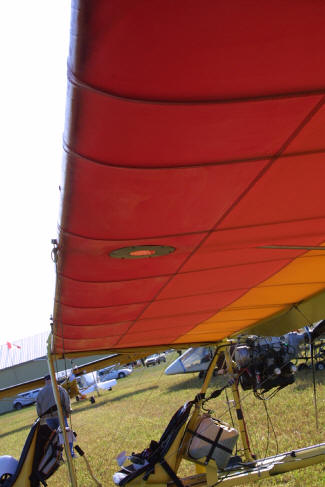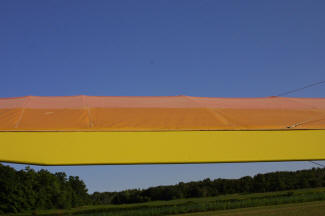|
In the early days of ultralights, ultralight aircraft were no more than
hang gliders with power packs. The little Mac 101, Chrysler Westbend, Pioneer chainsaw and
little Solo engines lifted lightweight hang gliders into the air for short 15 minute
interludes of flight.
These flights occurred early in the morning or late in the
evening, just before dawn or dusk. The pilot would arrive at his chosen flying sight with
his little glider all wrapped up in its bag. The assembly neatly tied to a one off
designed roof rack, usually on top of a Volkswagen Beetle with 8 feet of bag hanging over
front and back. Once the flight was over back into its bag the glider would go.
The average pilot would put in about 10 hours of flight in a
year. This meant that his aircraft had a total of 10 hours of ultraviolet exposure in a
year, all at times when the sun's rays were at their weakest.
Todays ultralights are considerably different
than that of their predecessors. Today the craft are no longer folded down into bags, but
are left out in the open, in farmers fields, or small open hangars.
In the fields they are exposed to UV light 8 to 12 hours a day
365 days of the year. If hangared or covered they are still exposed to UV when the craft
is flown.
In training we average about 450 hours a year. This is logged
hours using an hour meter on the engine. It does not consider the time the craft is left
outside uncovered while we're talking to students, waiting for weather to clear, or having
a bite to eat. Life expectancy for this fabric in these conditions in Canada has been
shown to be about a year.
Pilots first noticed the fading when they compared the underside
coloring of the wing to that of the top side. Since little was known about the life
expectancy of the fabric, and no other signs were evident to warn the pilot of fabric
weakening, many pilots just kept on flying their planes. Unaware of the potential for
disaster.
On visiting a flying sight in Florida a friend asked me if I
would like to fly his ultralight. The craft in question was less than a year old, but the
fabric was badly faded on the top side. While doing a preflight I tripped and fell, in an
attempt to prevent the fall, I grabbed the leading edge of the wing. MY FINGERS WENT RIGHT THROUGH THE FABRIC,
In
fact I able to run my baby finger along the fabric and tear it, with out any discomfort at
all. In
fact I able to run my baby finger along the fabric and tear it, with out any discomfort at
all. In
fact I able to run my baby finger along the fabric and tear it, with out any discomfort at
all. In
fact I able to run my baby finger along the fabric and tear it, with out any discomfort at
all.
Later tests showed the fabric strength to be less
than 15 lbs
According to sources in the industry this same
dacron fabric
when new, should test out at between 95 and 110 lbs.
Maule instrument test information indicates that a
minimum of
46 lbs is the strength requirement for fabric on " light" aircraft.
Question: What product works?
Ladies and gentlemen, I am not a mechanical engineer, nor do I
have an aeronautical engineering degree. The only way I have of knowing whether something
works or doesn't work is to try it, or test it along side other products, or rely on
information that I can obtain from people in the industry that I trust.
Another source of information that has proven invaluable is the
Canadian Aviation Safety Board, and other government funded agencies.
In early 1984 an ultralight manufacturer that I deal with
indicated that they had a product that they were trying in the hope of extending fabric
life.
That product was Stits Aerothane A 100 101. In my opinion this
product works, on dacron sail cloth to extend fabric life!
How do I know it works? By the only way I have available to me
with my limited knowledge of these kinds of products. I have tried it! First on one of my
own aircraft. This aircraft is now over 4 years old since coated, and has been left
outside unprotected from the elements for 8 months each year since 1984.
The fabric on this plane has been tested 12 times to date, to 75
lbs using a Maule fabric tester, and at no time has the tester punctured the Stits coated
dacron fabric. This fabric was finally replaced in 1992. While the fabric still tested
good the threads holding the fabric together failed!
Another test that I did was to put 4 pieces of fabric out in the
Florida sun on racks. Each piece of fabric was the same color, from the same bolt of
material. Two pieces were covered in products advertised to prevent UV deterioration. One
with Stits A0 100, the last left bare.
The only coating that stood the test of time was the Stits. In
less than six months, (in Florida) the bare fabric, and the two that were coated in other
so called UV barriers tested to less than 25 lbs.
The last test I was able to do on the Stits coated panel was in
February 1988 when the fabric tested to 53 lbs. (Since then my mother- in- law thinking
it was scrap through the panel in the garbage, thus destroying my chances of a Pulitzer
prize for R & D into the life expectancy of 3.9 oz dacron in the ultralight
environment.)
Question: Where is this product obtainable?
Answer: The Stits coating can be obtained from most of the
leading ultralight aircraft mail order houses.
Question: Can it be applied on older fabric and still work?
Answer: Yes if the fabric in question still tests to a limit that
you in your own mind would be happy with then it can be applied, and should maintain the
fabric in that state for considerably longer than if it weren't protected.
Question: How much does it cost?
Answer: That depends on how much of your aircraft you are going
to cover and how many coats you apply. Many owners only do the top surfaces of the wing,
and tail section on aircraft like the MX.
Other owners flying Buccaneers with double surfaced wings and
fuselage do the entire aircraft, including wings (upper and lower) body sock, and tail
surfaces.
The cost for an MX style aircraft, to put on FOUR , good coats is
about $250.00 US.
The cost for aircraft with double surfaced wings and enclosed
dacron covered enclosures is about $500 US.
Question: What equipment do I need to apply the coating?
Answer: This product can be applied several ways, by brush, by
roller, or by spraying it on.
The system I use and have had good results with is the spray on
technique. It does require that the person applying the product have some knowledge of
proper spray techniques, and application.
The other two systems do work but are not as professional looking
when the job is finished. A good spray job looks as if it has another layer of clear
fabric, right on top of the dacron.
Question: Are there any secrets, or hints for the first time
user?
Answer: Yes! Use as little air pressure as possible when
spraying, do all spraying in a well ventilated area, wear protective clothing, including
overalls, gloves, and breathing apparatus.
CAUTION THIS PRODUCT IS TOXIC
BREATHING APPARATUS MUST BE WORN!
Ensure that the area you are using is free of dust, otherwise the
dust will show up in the finish in when it dries.
When applying give the whole craft a good tack coat, and wait
about 20 minutes between coats. Mix only the amount of material required (it is a two part
process) at one time, and to the specifications recommended by the manufacturer.
Temperature plays an important role in the application and drying process so make sure
that these recommendations are followed.
This information is available in the Stits Poly Fibre Aircraft
Coatings Catalog #300, and can also be found on the instruction side of the AO100 can.
Also make sure to have on hand the proper thinning agents (if
required), and cleaning solvents. A0100 hardens very quickly in the spray gun. We
destroyed several nozzles before reading the instructions and obtaining the proper
cleaner.
|



